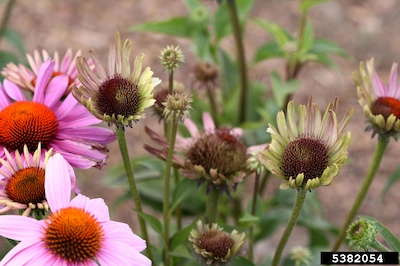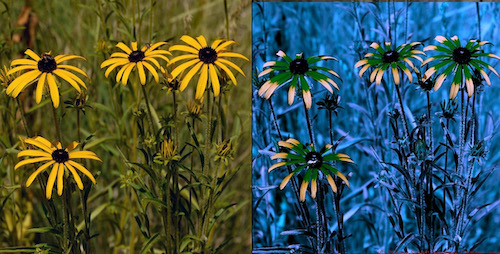Purple Coneflowers — in the Eye of the Bee-holder
By Ray Novitske, Fairfax Master Gardener

Purple coneflower
I am proud to be growing a native plant in my garden that is important to pollinators. Coneflowers are native to the eastern and central United States, and are found in prairies, meadows and open woods. They are also one of our continent’s most popular exports to European gardens where they are commonly cultivated as they are here.
Of the eight to nine true coneflower species, the purple coneflower (Echinacea purpurea) is the most common, and is the one that proliferates and seeds itself in my front yard. The scientific name is taken from the Greek word for hedgehog, echinos, because of its prickly center cone of seeds. (Well, this explains the name of the another pollinator magnet I also grow called echinops.)
Coneflowers are perennials that bloom in early summer (like right now) and continue to a lesser extent throughout the summer to autumn. They have strong sturdy stems that require no staking, and their flowers will last a week or more. These characteristics make them great cut flowers.
Deer do not find coneflowers appealing. This is especially true since the plants begin their annual growth in the spring when there are more tasty treats for the deer. Pollinators, on the other hand, find them irresistible. Echinacea is a botanical remedy that is supposed to boost the immune system and reduce inflammation. Plains native Americans used echinacea for numerous medicinal purposes.

Deadheading will assist in keeping coneflowers blooming throughout the summer, but letting the seeds develop also has benefits. Birds, especially goldfinches in my garden, chow down on the seeds in summer. Seeds ripen on our native purple coneflower at the time goldfinches are searching for seeds to raise their young. Goldfinches breed later than most birds, and they along with their young are vegetarians.
Coneflowers love well-drained soil and are known as drought-tolerant plants. They prefer full sun but will tolerate part shade, as some do in my garden. Dividing the plants should be done in the fall. They don’t require a lot of fertilizer, but some cultivars appear to respond to it better than our native purple coneflower.
There are few pests and diseases that affect coneflowers, but some are worth noting. Japanese beetles and aphids love to munch on them when there are no roses or other more delicious plants nearby. Tiny eriophyid mites that find their way into the flower buds, causing damage that stops some of the petals from forming. They overwinter in plant debris, so removing this in the fall helps keep them in check. Another notable problem is the Aster Yellows disease which is spread by leafhoppers. This can deform the flowers, causing green or yellow discoloration of the flowers or witches broom.
 Echinacea laevigata |
 Echinacea paradoxa |

‘Sundown’ Big Sky Series
Other notable varieties of coneflowers include Echinacea laevigata, a native from Virginia through Georgia, (and is an endangered species in some states), Echinacea pallida, and Echinacea paradoxa. These are mentioned because during the past 30 years, plant breeders have given us some new cultivars with striking colors — white, red, pink and orange. They also created drooping, double decker, mopheads, and pom-pom type blooms. These all came from crossing many of the different natural varieties.
But, these different crosses came with a price. Some are not as strong and prolific as our natives. I can attest to that with my ‘Sundown,’ part of a Big Sky series of cultivars. Although a beautiful salmon-orange in color, it has fewer blooms, is shorter and the petal colors fade and is not as long-lasting as the native purple coneflower. It also attracts fewer pollinators.

Human eye and bee’s eye ultraviolet view of rudbeckia coneflower
It has been discovered that bees prefer purple and blue colors, associating them with higher-pollen content. They cannot see red and oranges. But, bees can see ultraviolet colors that we cannot. Their attraction to most flowers is not due to color, but due to patterns on the flowers — patterns we cannot see. In fact, red and orange colors do not attract a bee’s eyes; the floral patterns in the flower’s ultraviolet colors that we don’t see do. These bulls-eye patterns on rudbeckia, conspicuous to bees but not our eyes, guide bees to the center where the pollen is found.

‘Coconut Lime’ pom-pom coneflower
Essential traits of some flowers can be altered or eliminated when we breed and create new cultivars for our own eyes. My salmon-orange coneflowers may not have the distinct ultraviolet patterns that attract bees. My pom-pom coneflowers certainly make it difficult or impossible for the bees’ proboscises to get to the pollen down deep inside the blooms. And, they do not produce edible seeds that birds desire.
So, if considering a coneflower to enjoy, explore the many new colors and shapes in making your selection. However, if you also want your coneflowers to feed the birds and the bees, you might want to stick to the native purple coneflower.
References
• About Echinacea, Bonnie K. McMillen, Carol J. Mulvihill, University of Pittsburgh at Bradford
• Coneflowers Have Changed, Dr. Leonard Perry, University of Vermont Extension
• Eastern Purple Coneflower, US Department of Agriculture Natural Resources Conservation Services
• Echinacea, Home & Garden Information Center, Clemson Cooperative Extension
• Echinacea purpurea, North Carolina State University Extension
• How Bees See and Why It Matters, Bee Culture, Magazine of American Beekeeping
• Wild Bees Preferentially Visit Rudbeckia Flower Heads with Exaggerated Ultraviolet Absorbing Floral
Guides, Lisa Horth, Laura Campbell, Rebecca Bray, Biology Open